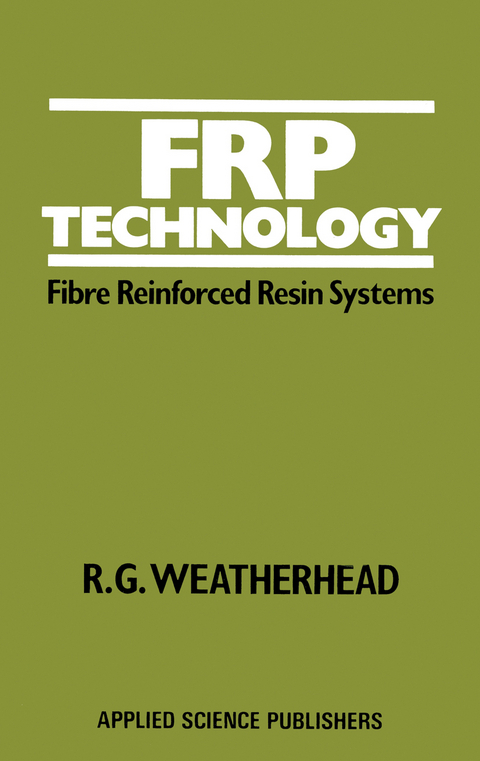
FRP Technology
Springer (Verlag)
978-94-009-8723-4 (ISBN)
1 General Introduction.- 1.1 Introduction.- 1.2 Why Use FRP?.- 1.3 Which Resin?.- 1.4 Reinforcements.- 1.5 Process Development.- 2 Designing in FRP.- 2.1 Introduction.- 2.2 Design.- 2.3 Flat Sheets.- 2.4 Building and Cladding Panels.- 2.5 Hollow Structures.- 3 Moulds.- 3.1 Introduction.- 3.2 Plaster Moulds.- 3.3 Wooden Moulds.- 3.4 GRP Moulds.- 3.5 Epoxide Resin Moulds.- 3.6 Steel Moulds.- 3.7 Aluminium Alloy Moulds.- 3.8 Nickel Shell Moulds.- 3.9 Other Moulds.- 4 Moulding Processes.- 4.1 Introduction.- 4.2 Contact Moulding—Wet Lay-up.- 4.3 Vacuum Bag Moulding.- 4.4 Pressure Bag Moulding.- 4.5 Resin Injection or Resin Transfer Moulding.- 4.6 Pressure Injection.- 4.7 Vacuum Impregnation and Injection.- 4.8 Foam Reservoir Moulding.- 4.9 Cold Press Moulding.- 4.10 Hot Press/Matched Metal Moulding.- 4.11 Transfer Moulding.- 4.12 Injection Moulding.- 4.13 Filament Winding.- 4.14 Centrifugal Moulding.- 4.15 Continuous Sheet Manufacture.- 4.16 Pultrusion.- 4.17 Sandwich Construction.- 4.18 Moulding with Preformed Materials.- 4.19 Trimming and Finishing.- 5 Common Faults Found in GRP Mouldings.- 5.1 Introduction.- 5.2 General Faults with Polyester Mouldings.- 5.3 Spray Moulding Faults.- 5.4 Faults with Translucent Sheeting.- 5.5 Press Moulding Faults.- 5.6 Resin Injection Faults.- 5.7 Vacuum Moulding Faults.- 5.8 Filament Winding Faults.- 5.9 Centrifugal Casting Faults.- 5.10 Faults with Epoxide Resin Systems.- 6 Bonding and Jointing Reinforced Plastics.- 6.1 Introduction.- 6.2 Adhesive Bonded Joints.- 6.3 Mechanical Joints.- 7 Maintenance and Repair of FRP Structures.- 7.1 Introduction.- 7.2 Maintenance.- 7.3 Repairs to GRP Structures.- 8 Site Application of Laminates.- 8.1 Introduction.- 8.2 Steel Structures.- 8.3 Concrete Structures.- 8.4 Wooden Structures.- 8.5 Repairs toPipelines—Concrete, Steel or Thermoplastic.- 8.6 On-site Tank Production.- 9 Polyester Resins.- 9.1 Introduction.- 9.2 Polyester Resins.- 9.3 Commercial Resins.- 10 Catalysts, Accelerators and Inhibitors for Unsaturated Polyester Resins.- 10.1 Introduction.- 10.2 The Curing Reaction.- 10.3 Catalysts or Initiators.- 10.4 Accelerators or Promoters.- 10.5 Inhibitors.- 10.6 Commercially Available Materials.- 11 Epoxide Resins.- 11.1 Introduction.- 11.2 The Resins.- 11.3 Diluents.- 11.4 How to Choose an Epoxide Resin.- 11.5 Commercially Available Resins.- 12 Curing Agents for Epoxide Resins.- 12.1 Introduction.- 12.2 Selection of Curing Agent.- 12.3 Amine Curing Agents.- 12.4 Anhydride Curing Agents.- 12.5 Polyamide Curing Agents.- 12.6 Other Curing Agents.- 12.7 Some Typical Laminating Systems.- 13 Other Resin Systems.- 13.1 Introduction.- 13.2 Furane Resins.- 13.3 Vinyl Ester Resins.- 13.4 Friedel-Crafts Resins.- 13.5 Silicone Resins.- 13.6 Polyimide Resins.- 13.7 Phenolic Resins.- 13.8 Melamine and Urea-Formaldehyde Resins.- 14 Reinforcements.- 14.1 Introduction.- 14.2 Surfacing Tissue.- 14.3 Glass Fibre Reinforcements.- 14.4 Carbon Fibre.- 14.5 Aromatic Polyamide (Aramid) Fibres.- 14.6 Other Reinforcing Fibres.- 14.7 Commercially Available Reinforcements.- 15 Dough and Sheet Moulding Compounds and Prepregs.- 15.1 Introduction.- 15.2 Dough and Bulk Moulding Compounds (DMC, BMC).- 15.3 Sheet Moulding Compounds (SMC).- 15.4 Prepregs.- 15.5 Commercial Products.- 16 Fillers and Pigments.- 16.1 Introduction.- 16.2 Mineral Fillers.- 16.3 Glass Fillers.- 16.4 Metal Oxide Fillers.- 16.5 Metallic Powder Fillers.- 16.6 Other Fillers.- 16.7 Thixotropic Additives.- 16.8 Flame Retardant Fillers.- 16.9 Pigments and Dyes.- 17 Miscellaneous Materials.- 17.1 Internal Lubricants.- 17.2Skin Formers.- 17.3 Light Stabilisers.- 17.4 Release Agents and Sealing Compounds.- 17.5 Core Materials.- 17.6 Coupling Agents.- 18 Laminating Equipment.- 18.1 Introduction.- 18.2 General Equipment.- 18.3 Spray Equipment for Polyester Resin Systems.- 18.4 Equipment for Saturating Glass Mat.- 18.5 Gelcoat Application Equipment.- 18.6 Resin Injection Equipment.- 18.7 Epoxide Resin Spray Equipment.- 18.8 Epoxide Resin Metering Equipment.- 18.9 Furane Spray Equipment.- 19 Handling and Safety Precautions.- 19.1 Introduction.- 19.2 General Precautions.- 19.3 Epoxide Resins.- 19.4 Curing Agents.- 19.5 Furane Resins.- 19.6 Polyester Resins.- 19.7 Peroxide Catalysts.- 19.8 Fillers and Pigments.- 19.9 Barrier and Cleansing Creams.- 20 Test Specifications.- 20.1 Introduction.- 20.2 Chemical Properties.- 20.3 Fire and Smoke Tests.- 20.4 Mechanical Properties.- 20.5 Physical Properties.- 20.6 Thermal Properties.- 20.7 Electrical Properties.- 20.8 Miscellaneous Test Specifications.- Appendices.- 1 Trade Names.- 2 General Material Suppliers.- 3 Company Names and Addresses.- 4 Units, Prefixes and Conversion Factors.
| Zusatzinfo | XVII, 462 p. |
|---|---|
| Verlagsort | Dordrecht |
| Sprache | englisch |
| Maße | 140 x 216 mm |
| Themenwelt | Sachbuch/Ratgeber ► Natur / Technik ► Garten |
| Naturwissenschaften ► Physik / Astronomie ► Allgemeines / Lexika | |
| ISBN-10 | 94-009-8723-4 / 9400987234 |
| ISBN-13 | 978-94-009-8723-4 / 9789400987234 |
| Zustand | Neuware |
| Haben Sie eine Frage zum Produkt? |
aus dem Bereich


